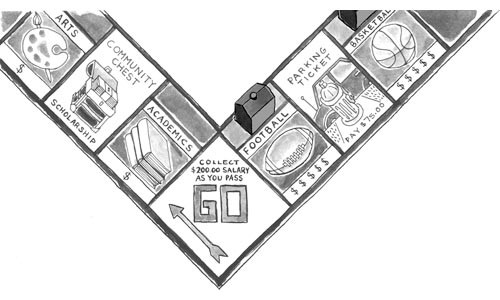As you, or your family, writes out that massive tuition check, you can at least take solace knowing that your university values academics as much as you do, right?
Well, maybe. But at big schools especially, university tax documents suggest, they love their coaches even more.
According to a study --The Annual Report on the Economic Status of the Profession -- released earlier this year by the American Association of University Professors, the national average salary for a full college professor is $104,523. Which is a good living, even if fewer and fewer professors reach that plateau. But even an economics professor with tenure will tell you the real money is being a Division I football coach: According to the AAUP, the average salary for that post is over $1 million a year. That's more than double the $416,719 average salary paid to university presidents, who run the entire school.
"Although the issue has gotten a lot of attention, I don't see immediate improvement on the horizon," says John Curtis, the director of research and public policy at the AAUP. "I think we're losing perspective when it comes to what is the real purpose for college athletics and what these coaches are getting paid."
Pittsburgh's college-sports powerhouse, of course, is the University of Pittsburgh. And while local salaries don't touch the $4 million a year earned by University of Alabama football coach Nick Saban, they do crush the faculty average. According to the AAUP's study, full professors at the University of Pittsburgh average $121,900. Compare that to the $829,733 salary of football coach Dave Wannstedt, who has posted three losing seasons since coming to the Panthers in 2005 from the pros. Or the $1.7 million in salary and benefits shelled out to men's basketball coach Jamie Dixon.
But the bottom line for most universities is that college sports, especially successful ones, make a lot of money. At the University of Pittsburgh, according to statistics recorded by the United States Department of Education, the football program brought in a profit of $15.3 million in the 2007 fiscal year. The men's basketball team earned $6.5 million. (Women's hoops earned $1.2 million, but all the other sports combined bring in just under $80,000. Which is why the school doesn't hire big-dollar swimming coaches.)
You can pay a lot of professors for that kind of money. Even at a school like Duquesne University, whose athletic renown has been, well, uneven in recent years, the athletic department nets a $200,000 profit.
These facts aren't lost on Curtis. Getting into a major bowl game "ultimately leads to a lot of money for the university," he concedes. But that doesn't make it right, he insists.
"What does that say about the priorities of the university, whose core reason for existence is supposed to be teaching and research?" Curtis asks. And it's not as if sports programs are generating massive windfalls, he adds: Even as coaches receive large salaries, regular faculty members are experiencing salary freezes or "raises that don't even cover the increase in the cost of living."
"We've had this extremely rapid rise in coaching salaries because it seems like universities are trying to keep up with the Joneses," he adds. "One salary feeds off the next."
There are exceptions: Joe Paterno, the legendary Penn State coach, makes less than a half-million a year. (Curiously, Penn State fought to prevent that fact from ever being known; it took a protracted court battle for reporters to unearth his salary, even though the school receives taxpayer money.) Given that Penn State earns more than $44 million in revenue from its football team, Paterno may be the best investment in college athletics today.
Duquesne basketball coach Ron Everhart's $350,000 a year may seem paltry compared to his cross-town rivals, but it's still munificent: Everhart's compensation is only slightly less than that of university President Charles Dougherty, who earns $381,902 a year.
But not everyone has succumbed to the siren song of big sports. Robert Morris University is a full-service university with a host of athletic teams, and its head football coach, Joe Walton, was a former coach in the NFL. And yet neither he nor any other coach ranks among the school's top earners. At Robert Morris, to be a coach means suffering the indignity of taking a back seat to such figures as the provost ... and even the dean of education.



















